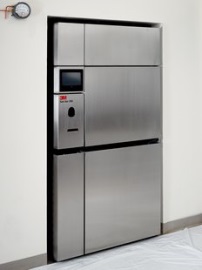
by Brianna Crandall — May 8, 2015—Recent CRE outbreaks traced to inadequately processed duodenoscopes have highlighted the need for healthcare facilities to review cleaning and sterilization processes. In the case of a facility in northeastern Illinois, after the hospital changed its reprocessing procedure from automated high-level disinfection to ethylene oxide sterilization, no additional cases of CRE transmission were identified, according to a report cited by global technology giant 3M. Ethylene oxide (EO) sterilization provides an overkill sterilization process, which means that there is a large safety margin built in to the cycle, explains 3M.
For facilities looking for effective reprocessing methods for heat- and moisture-sensitive equipment, the new 3M Steri-Vac Sterilizer/Aerator GS Series may be the solution. Instruments made of sensitive materials require sterilization solutions that are both budget-friendly and effective at killing microorganisms; sterile processing managers require solutions to help them effectively manage the increasing complexity of instrument reprocessing.
The 100 percent ethylene oxide (EO) sterilant used in the Steri-Vac sterilizer GS series effectively penetrates the complex geometries of instruments, such as long-lumen flexible endoscopes. Many instruments that require low-temperature sterilization can also be sterilized using EO (always refer to the instrument manufacturers’ Instructions for Use for validated sterilization modalities and cycles, cautions 3M).
EO is gentle on materials, which may extend the life of instruments or reduce the frequency or cost of repairs, says the company. EO has been safely used in the health-care industry for more than 50 years, adds 3M, and EO has also been used in medical device, government, and other industries for decades. According to Global Industry Analysts, over half of all sterilized single-use medical products are sterilized with ethylene oxide.
The Steri-Vac sterilizer GS series is designed for staff safety, says 3M. 3M Steri-Gas Cartridges, single-use EO gas cartridges, are punctured only when the sterilizer chamber door is sealed and the proper vacuum has been drawn, ensuring that gas stays safely inside the chamber, explains the company. The entire sterilization cycle proceeds under vacuum (below atmospheric pressure), and minimum aeration is pre-programmed in each cycle. The GS series sterilizers also offer a color touch screen on the front panel that displays key information, making it easy for the operator to monitor the cycle.
As the gold standard for low-temperature sterilization, EO is a reliable solution to sterilize even the most challenging devices. While there will always be a need for multiple types of sterilization processes, EO may be preferable to hydrogen peroxide (H2O2) when instruments are sensitive to oxidizing agents, points out 3M. The company also says that EO is highly effective and lower in cost than leading H2O2 systems, comes with no restrictions on the length or inner diameter of endoscope channels, and has excellent materials compatibility. H2O2 is reportedly a strong oxidizer and can result in damage to instruments.
“Patient protection is the ultimate goal of all sterilization processes, and the Steri-Vac sterilizer GS series gives facilities an effective tool for low-temperature sterilization,” said Tushar Kshirsagar, global business director, 3M. “Facilities are choosing ethylene oxide sterilization over high-level disinfection for high-risk instruments to raise the standard of care. As noted by the Association for the Advancement of Medical Instrumentation (AAMI) and the U.S. Food and Drug Administration (FDA), ‘Disinfection processes do not ensure the margin of safety associated with sterilization processes.'”
3M also provides the elements of a strong sterilization quality control system utilizing biological, chemical, and physical monitors for every cycle. To monitor cleaning efficacy prior to sterilization, particularly for difficult-to-clean flexible endoscopes, sterile processing managers may establish a quality control protocol using the 3M Clean-Trace ATP Cleaning Monitoring System. The Clean-Trace system provides a quantitative measure of contamination at established test points to help facilities verify cleaning efficacy.
Considering recent information on the increased risk for endoscopy-associated infection, it is important to implement a routine monitoring program that detects reprocessing errors and monitors levels of endoscope contamination, says 3M. The company points out that a robust monitoring program supports and promotes proper endoscope reprocessing while verifying effectiveness, thus supporting increased patient safety.
For more information about the 3M Steri-Vac Sterilizer/Aerator GS Series, visit the 3M Web site.




